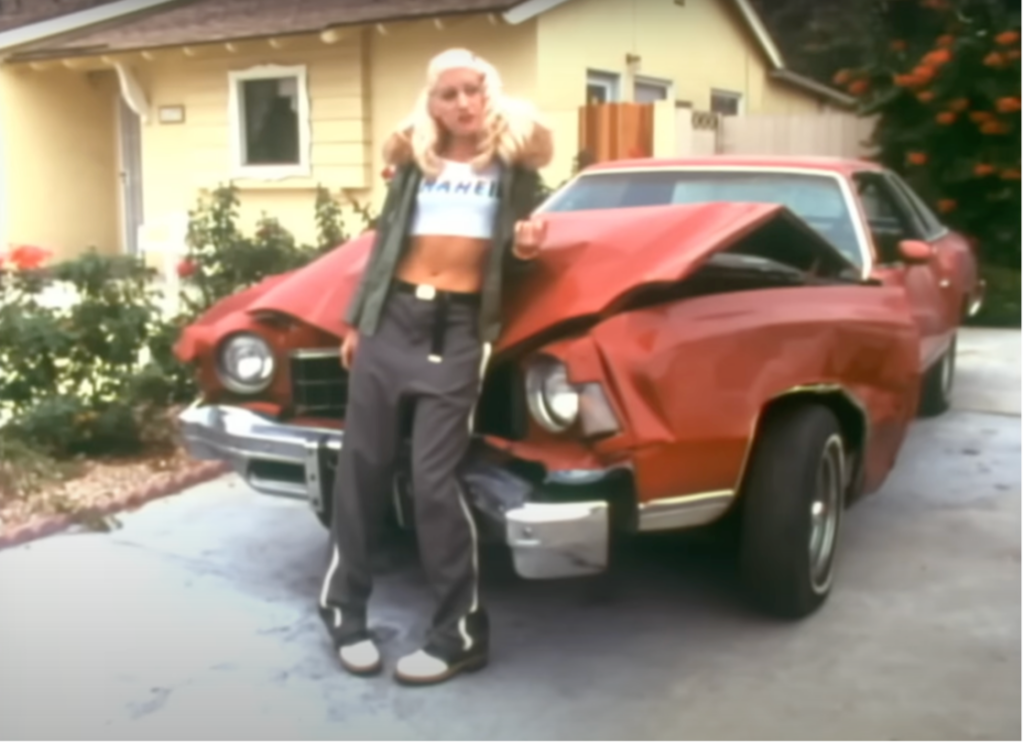On April 13th, 2024, No Doubt performed one of their most iconic songs “Just A Girl” at the Coachella Music Festival, 29 years after its initial release. Following their release, “Just A Girl” received positive reviews from multiple music critics and later “Just A Girl” became a feminist anthem for many feminists. Through its satirical lyrics, Gwen Stefani portrays the struggle it is to be a woman in America. Although released in 1995, “Just A Girl” is a song beyond its years.
In the first clip that can be found on YouTube, Gwen Stefani is seen standing in front a red crashed car:

Gwen Stefani, a woman, standing in front of a crashed car is a metaphor for the common misconception that women are bad drivers. These sexist notions have been surrounding society for decades and yet, they hold no truth to them. Men are twice as likely to get into a fatal car crash (Kelly).
While Gwen Stefani is standing in front of a crashed car, the lyrics that follow are:
[Verse 1]
Take this pink ribbon off my eyes
I’m exposed, and it’s no big surprise
Don’t you think I know exactly where I stand?
This world is forcing me to hold your hand
The “pink ribbon” being removed from Gwen Stefani’s eyes is symbolism that displays the lies of womanhood. The pink color is a mask of the truth that hides behind the reality of what it is being a woman, constantly being suppressed and undermined. Pink is chosen to criticize the stereotype that pink is a “girl color”. These gender color assignments did not begin until the 20th century. Originally, pink was a color for boys and blue was a color for girls because, “pink, being a more decided and stronger color, is more suitable for the boy, while blue, which more delicate and dainty, is prettier for the girl” (Grannan). Which is contrary to the modern notion that pink is “girl” color. This proves that colors should not be associated with a specific gender.
In Gwen Stefani’s lyrics she is being forced to hold hands which displays the patriarchal standards of women being forced to be with men to “have” a role in society. Often times, especially in the 90’s women are more recognized and treated with respect if they have a man by their side. Stefani shuts down and criticizes these widely held beliefs that women are worthy only if they are with a man.
[Chorus]
‘Cause I’m just a girl, oh, little old me
Well, don’t let me out of your sight
Oh, I’m just a girl, all pretty and petite
So don’t let me have any rights
The use of the words “little”, “pretty and petite”, illustrate the societal view of women being seen as dainty and fragile. This ideology makes it difficult for women to progress when they are limited by being viewed as defenseless and needing a man to make any progress.
[Post-Chorus]
Oh, I’ve had it up to here
[Verse 2]
The moment that I step outside
So many reasons for me to run and hide
I can’t do the little things I hold so dear
‘Cause it’s all those little things that I fear
“So many reasons for me to run and hide” displays the fear that woman constantly face when they are alone. Society has created woman to be afraid of so many things because of what many men have done to women such as rape, murder, etc. The inability in pursuing a normal life highlights the difference between a man and a woman’s day to day life. A man can do anything he wants without fearing for his safety, whereas a woman cannot.
[Chorus]
‘Cause I’m just a girl, I’d rather not be
‘Cause they won’t let me drive late at night
Oh, I’m just a girl, guess I’m some kind of freak
‘Cause they all sit and stare with their eyes
Oh, I’m just a girl, take a good look at me
Just your typical prototype.
Stefani continues her song by demonstrating strict rules she must follow because she is a female. Because she is a female, she cannot drive late at night. It is incredibly common to be stopped by your parents from going out late at night because you are a woman. Being from a Hispanic household, I would have to beg my parents to let me drive out late. I always knew that if I was not a female, there would be no issue with me driving out at night. These sexist ideologies founded in multiple households do not end with a singular restriction. There are still multiple restrictions that girls from a young age must face because of their gender. These restrictions are even more so emphasized if they are from a non-white household.

Throughout the video, Stefani is seen in an orange and cyan room with two ladies in blue dresses in a corner. Images of a men’s bathroom in black and white also flash throughout the video. Gwen Stefani is separated from the men’s bathroom which is dirty and grimy which is a foil of the clean bathroom with the two ladies to create symbolism of how society treats women like overly emotional creatures. Stefani stays in this clean bathroom throughout the music video to stay true that Stefani is “safe” in this restroom away from the rest of the world.
In the end of the music video, both sides (the dirty bathroom vs the clean bathroom) come together to display that woman can handle the “dark parts” of the world, just like men.
The enduring power of “Just A Girl” by No Doubt lies in its ability to capture the persistent struggles and stereotypes women face, even decades after its initial release. Gwen Stefani’s poignant and satirical lyrics, coupled with the vivid imagery in the music video, highlight the societal constraints placed on women and challenge these outdated norms.
The song’s performance at the 2024 Coachella Music Festival underscores its timeless relevance and continued resonance with audiences. Through “Just A Girl,” No Doubt not only crafted a feminist anthem but also a cultural critique that remains strikingly relevant in the ongoing discourse on gender equality. The song and its accompanying visuals serve as a powerful reminder of the progress made and the journey still ahead in dismantling gender stereotypes and advocating for women’s autonomy and rights.
Works cited:
Kelly, J. (2015, May 27). The Kelly Law Team. Phoenix Personal Injury Lawyer. https://www.jkphoenixpersonalinjuryattorney.com/whats-that-about-women-drivers-better-think-again/
Grannan, C. (2016). Has Pink Always Been a “Girly” Color?. In Encyclopædia Britannica. https://www.britannica.com/story/has-pink-always-been-a-girly-color